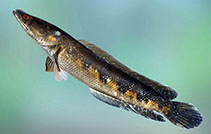| Family: |
Channidae (Snakeheads) |
| Max. size: |
65 cm SL (male/unsexed) |
| Environment: |
benthopelagic; freshwater; depth range 0 - 1 m |
| Distribution: |
Asia: Sri Lanka. |
| Diagnosis: |
Dorsal soft rays (total): 47-48; Anal soft rays: 29-30; Vertebrae: 56-56. This species is distinguished from C. marulius, C. aurolineata, C. auroflammea by having fewer vertebrae 56 (vs. 59-63 in marulius; 63-66 in aurolineata; 58-61 in auroflammea); fewer lateral-line scales 59-62 (vs. 62-65 in marulius; 65-71 in aurolineata; 61-65 in auroflammea); fewer dorsal-fin rays 47-48 (vs. 50-56 in marulius; 55-58 in aurolineata; 52-54 in auroflammea); and fewer anal-fin rays 29-30 (vs. 32-37 in marulius; 35-38 in aurolineata; 33-36 in auroflammea); distinguished from aurolineata and C. marulioides by the white spots along mid-lateral blotches faint or absent (vs, series of black scales rimmed in white along the mid-lateral dark blotches) in live adults; differs to South Indian C. pseudomarulius, by having more vertebrae 56 (vs. 55) and having more circumpeduncular scales 26-28 (vs. 24); differs C. cf. ara from the southwestern wet zone of Sri Lanka by having more circumpeduncular scales 26-28 (vs. 22-24); by the absence or faintness of the numerous large white spots along the mid-lateral dark blotches (vs. presence of spots in C. cf. ara) and by bright orange colouration in between the mid-lateral series of dark brown blotches when alive (vs white to yellow colouration)(Ref. 127648). |
| Biology: |
This species occurs primarily in the deep pools in the Mahaweli River and its tributaries. Also recorded from reservoirs in the Mahaweli catchment (Victoria and Randenigala). Around 20 juveniles (ca. 8.0-10.0 cm SL), guarded by a pair of adults, were observed in shallow water (ca. 60-80 cm deep), among submerged roots, close to the bank, at the mouth of a stream draining into Badulu Oya of the Mahaweli basin. The highest recorded elevation from which this species was found was about 500 m asl at Kandy (Ref. 127648). |
| IUCN Red List Status: |
Not Evaluated (N.E.) Ref. (130435)
|
| Threat to humans: |
harmless |
| Country info: |
|
Source and more info: www.fishbase.org. For personal, classroom, and other internal use only. Not for publication.

